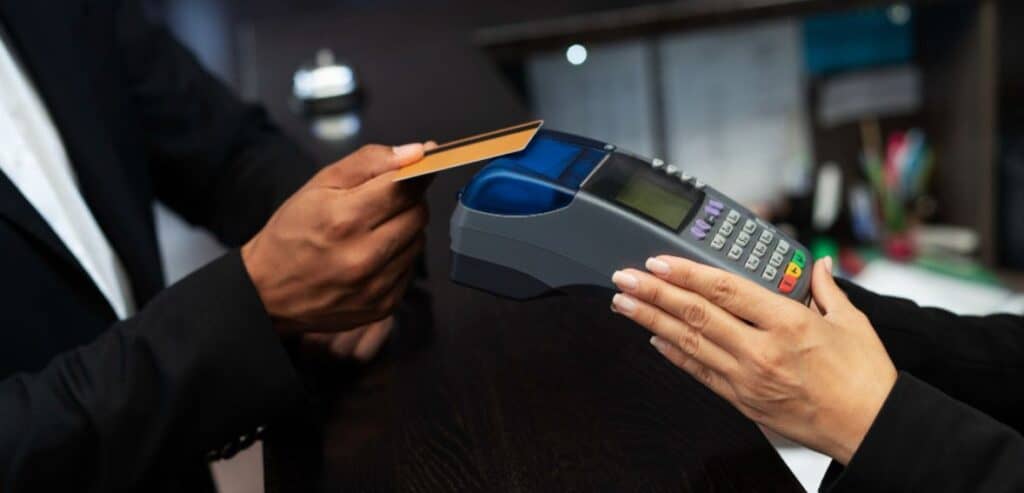
By JudyJEngland November 1, 2025
If you operate a business in Maine and are considering dual pricing (charging cash vs. card differently), knowing the current regulatory landscape is important to avoid legal troubles. While Maine prohibits surcharging (charging additional fees for the use of credit cards), dual pricing is still lawful—with regulations. In 2025, you will need to be transparent, comply with state regulations, and abide by card network guidelines to operate your business smoothly.
Understanding Dual Pricing vs. Surcharging

Surcharging: Prohibited in Maine
Surcharging involves charging a tiny added amount when one pays with a credit card to recover processing fees. Although this is acceptable in most states, Maine forbids it. The primary motivation is consumer protection.
The state aims to make customers aware of what they are paying before they leave the store. Last-minute or hidden charges leave customers feeling deceived or overcharged. As a result, companies in Maine are forced to find alternative means of controlling their payment expenses.
Dual Pricing: A Clear and Legal Alternative
Dual pricing is a transparent and straightforward means of remaining in compliance while coping with card charges. Rather than charging a fee at the point of checkout, you display two prices initially—one for cash and another for card payments. For instance, a sandwich could be priced at $10 for cash or $10.30 if it’s paid by card.
This method is clear, transparent and encourages payment with cash, which can decrease processing fees. In contrast to surcharging, dual pricing is transparent, making it simpler to uphold client trust and while still keeping your enterprise within Maine’s legal boundaries.
Maine Credit Card Surcharge Laws Explained (and Legal Alternatives for Businesses)

If you’re a business owner in Maine, you should be aware that surcharge fees cannot be charged on credit or debit card payments. This is applicable to nearly every business except a few exceptions. Nevertheless, there are lawful ways to deal with processing fees, such as providing cash discounts or dual pricing. Here’s a review of what the law states and how you can remain compliant while maintaining your profit margins.
Government Exceptions
In Maine only government agencies can impose surcharge fees for card payment. This means that ordinary businesses, regardless of size or type, cannot impose additional fees when consumers pay with credit or debit cards. Government agencies or licensed third-party collectors can impose these fees on transactions such as taxes, permits, licenses, fines, or utility bills. However they must indicate the fees openly, and the surcharge cannot be greater than the actual processing fee.
Cash Discounts and Dual Pricing
Although surcharges are off-limits, cash discounts and dual pricing schemes are absolutely legal in Maine. The only difference is that these methods reward customers for using cash rather than penalizing customers who use cards.
A cash discount program enables you to promote a lower price when paid in cash. Let’s say your standard price is $100; you can promote a $97 cash price. The standard price is still the same for credit card consumers—so you’re not charging a fee, but providing a short discount for cash payment.
Dual pricing operates similarly, but rather than providing a short discount, you display both prices—one for cash and the other for card payments. For example, your price tag or menu may indicate “Cash: $97 / Card: $100.” This approach maintains transparency and allows customers to make their desired payment with ease.
Card Network Rules: The Other Compliance Layer
When implementing dual pricing, simply adhering to state or federal regulations is not sufficient. You must also comply with the regulations established by credit card brands such as Visa, Mastercard, American Express, and Discover. Each of these networks has its own guidelines for dual pricing and surcharges, and they can differ significantly.
For instance, Visa and Mastercard both insist that businesses register their surcharge plans at least 30 days in advance of implementation. They also have thresholds on how much you can surcharge. Visa permits up to 3% or your true cost of processing—whichever is less. On the other hand Mastercard permits up to 4%.
Both networks also insist on transparent communication with consumers. That means you must always display surcharge information at the entrance, at checkout, and on the receipt.
American Express and Discover also have their own policies. They used to be more strict about surcharges, but have caught up with Visa and Mastercard more recently. There are still minor differences, though. For instance, if you do accept American Express, you must enroll your pricing structure through Amex’s merchant platform first before opening.
Every card network has its own compliance guidelines, and knowing these facts can assist you in avoiding penalties, ensuring transparency, and gaining customer confidence when implementing dual pricing.
Key Things to Know Before Setting Up Dual Pricing

Before introducing a dual pricing system, it’s essential to carefully evaluate how it might impact your business. Every business operates differently, so what works for one may not work for another. Start by looking at your POS system—ensure it supports dual pricing with automated tools, to make implementation easier and compliant.
Next, review your merchant service provider’s fees. Excessive processing costs can impact profits, so negotiate more favorable rates prior to charging customers.
Dual pricing is most effective when many of your customers already pay by cash, check, or ACH, as it gives them a small discount and reduces the processing fees for you. Your staff must be trained on dual pricing, including how to explain options clearly and apply the pricing accurately at checkout. Transparent payment signage and clear messaging make customers aware of the cash discount or dual pricing, which helps to build trust and minimize complaints.
If these points are taken into careful consideration, dual pricing can be effectively implemented, with transparency, cost savings, and a smoother checkout process.
Employees Training Basics for a Seamless Dual Pricing Implementation

To work your dual pricing efficiently your staff needs to be properly trained. Effective training prevents confusion, maintains compliance, and ensures customer satisfaction. Staff needs to be able to explain how dual pricing operates, respond to the common questions, and process card and cash payments correctly. Well-trained staff not only avoids errors but also informs and respects customers.
Here’s an easy checklist to direct your staff training:
- Train staff on how to operate the POS system for dual pricing properly.
- Provide them with easy-to-use scripts to communicate the prices to customers.
- Role-play how to handle customer objections or questions tactfully.
- Discuss compliance regulations and where to place pricing signage.
- Conduct role-playing for various customer scenarios.
- Match new employees with experienced team members for guidance.
- Have refresher training every few months to maintain knowledge.
- Offer a reference guide for steps in payment and pricing quickly.
- Develop an FAQ sheet to respond to frequent customer queries.
- Encourage personnel to exchange customer feedback and issues.
With proper training and assistance, your team can handle dual pricing confidently so that the system can function smoothly and customers remain satisfied.
Advantages of Implementing Dual Pricing

One of the greatest advantages of dual pricing is that it encourages cash payments. If your company wishes to cut credit card charges, this arrangement can have a real impact. Just ensure you market your prices effectively so customers are aware that they can save if they pay in cash.
Dual pricing also serves to lower payment processing costs. Although the average processing fee itself may not appear to be large—about 2–3%—however it can add up and impact your bottom line.
Lastly, dual pricing is empowering for your customers. It allows them to decide how they wish to pay and see the variation in price upfront. This type of transparency instills confidence and reduces the possibility of customers feeling cheated or overcharged, leading them to come back for more.
Cons of Using Dual Pricing
Whereas dual pricing can reduce expenses, it’s not always flawless. Perhaps the most significant disadvantage is the possibility of negative customer response. Customers who prefer paying with a credit card may feel unfairly treated or charged more for their convenience. As most consumers like to pay according to their preferred payment method, this sometimes results in a decrease in repeat customers.
Another challenge is the need to follow regulations. Even though dual pricing is legal in every state, there are still some complicated rules on how it must be displayed and communicated. These regulations can also change over time, so you’ll need to stay updated to avoid mistakes or penalties.
Lastly, dual pricing can add extra work for your team. You’ll need to make sure both prices are shown clearly on receipts, menus, and signs. Managing updates, keeping things organized, and training staff on how to explain the pricing can take time. Working with a processor or software that supports dual pricing can make this process easier and reduce stress on your staff.
Surcharging Alternatives for Maine Businesses
Since surcharging is prohibited in Maine, entrepreneurs must resort to other means of coping with increasing credit card processing costs. Even though cash discounts and dual pricing are permissible alternatives, they do not always address the issue entirely—particularly because a lot of customers already favor paying by card.
To keep costs under control, start by negotiating better rates with your current payment processor. You’d be surprised how often providers are willing to adjust fees to keep your business running. Next, review your monthly statements carefully to spot hidden charges or unnecessary fees. These small costs can quietly add up over time.
Lastly, do not keep changing processors to pursue a lower rate. Those “introductory deals” often don’t last, and constant changes can cost more in setup fees, downtime, or retraining. Rather, settle for a transparent and efficient payment arrangement that aligns with your business goals for the long term.
The Future of Dual Pricing: Trends and Innovations to Watch

The payments landscape is moving at a rapid pace, and staying ahead of emerging trends enables businesses to remain competitive and compliant.
Perhaps the greatest change will arise from innovative payment methods like cryptocurrency, mobile wallets, and “buy now, pay later” (BNPL). Each of these methods carries processing fees, so businesses might be required to revise their dual pricing schemes to achieve the actual cost of each payment method.
Artificial intelligence also has a significant role to play in the future of pricing. AI systems are able to read data in real time to modify prices according to demand, competition or loyalty schemes.. This extent of dynamic pricing can enable firms to be competitive without compromising fairness and transparency for customers.
Most countries are heading towards surcharging but with more restrictions to safeguard consumers. Companies that remain compliant and up-front will be in a position to adapt better as these regulations change.
Conclusion
Dual pricing might be a good strategy for Maine companies to deal with increasing payment processing fees while remaining compliant with state regulations. As surcharging is not allowed, dual pricing is an open and lawful option that presents customers with an easy choice between both cash and card payments.
Business owners must comply with state laws and card network regulations, adequately train their employees, and employ effective POS systems that provide dual pricing to run their business effectively. With proper planning, dual pricing can assist Maine businesses in remaining competitive and safeguarding their bottom line for 2025.
FAQs
Is dual pricing legal in Maine?
Yes, dual pricing is legal in Maine so long as both the cash and card prices are displayed transparently.
How does dual pricing differ from surcharging?
Dual pricing displays two initial prices, whereas surcharging charges an additional fee at the point of checkout for credit card purchases.4
Do I require special equipment for dual pricing?
Yes, you will need a POS system capable of displaying and processing two distinct prices automatically.
Does dual pricing frustrate customers?
It could, unless clearly explained, so signage and transparency are important for customer knowledge.
Does dual pricing save companies money?
Yes, it can save them money on credit card processing fees and increase cash payments.
Leave a Reply